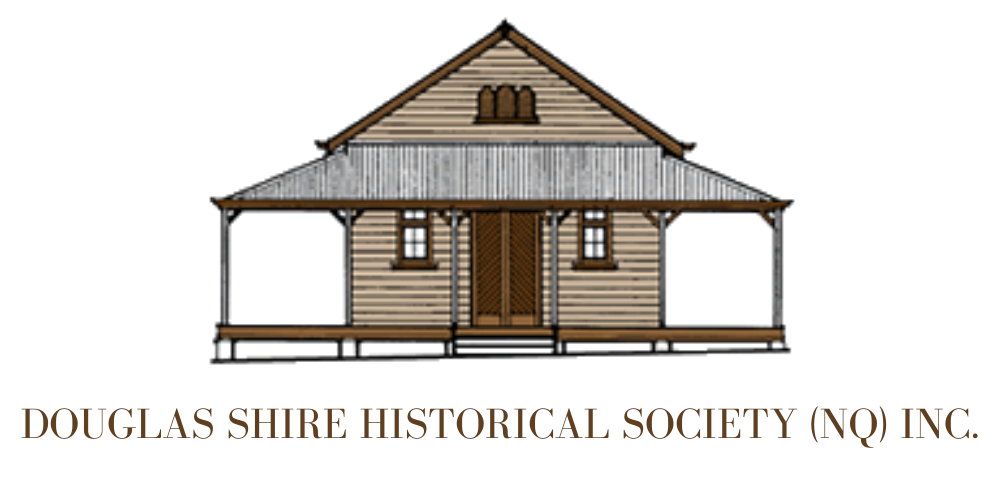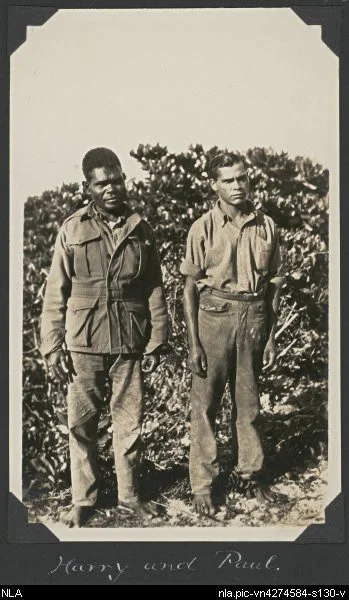Low Isles
On Queensland's Great Barrier Reef, the Low Isles (Islets) are two small islands located 15 kilometres from Port Douglas. They are situated on the western edge of the main shipping channel.
One is known as Low Isles, a coral cay, and the other as Woody Island, a mangrove island. This combination of cay and mangrove island is a special island type-a low wooded island-and is unique to the Great Barrier Reef. Woody is a protected area.
Local Indigenous people know these islands as Wungkun. It is an important Indigenous cultural site for both the Kuku Yalanji and Yirraganydji people. The Sea Country of both groups overlaps at Low Isles.
Bristow, John (2017). Detailed map of Low Island showing physical attributes and locations, Queensland, 1954.
1770
Jun 10 / Lieutenant James Cook, sailing past Low Isles in HMS Endeavour made a note in his log describing a "small low island" about 2 Leagues from the Main.
1819
Jun 24 / Capt Phillip Parker King on the cutter Mermaid officially named Low Isles and Cooktown, previously Cook’s Town
1842
The first to study the Reef was Prof. Joseph Beete Jukes who came on the survey vessel HMS Fly.
1860s and 1870s
A beche-de-mer station was established.
1877
May / The tender to erect a lighthouse and cottage was approved. The 18-metre tower was constructed on a timber frame with a galvanised sheath in the typical Queensland fashion. Attached to the top was a 1.5m diameter lantern.
1878
Nov / The light was exhibited for the first time from the new lighthouse, the first keeper being Captain Daniel Owen, previous master of the S.S.Corea.
The original oil wick light was upgraded to kerosene in 1923, to electricity in 1963 and finally converted to solar power in 1993, when the station was de-manned. The original 1878 lens for the light is on display in the Court House Museum.
1887
First official weather observations are recorded.
1902
Mar 19 / Assistant lighthouse keeper William Hannah, aged 42, his daughter Doris Irene Margaret Wallace Hannah aged 14 and son William Thompson Escar Hannah aged 10 went missing in a dinghy. They disappeared without trace.
Jul / Hugh Nibloe arrived from Glasgow to be the lighthouse keeper. His wife Agnes, and two daughters Jessie and Alice, followed in 1908. Woody Island then was called Low Woody. The head keeper was Mr Simpson.
1911
Oct / Three bodies were found at Cape Flattery. At first they were thought to be missing young men from the Valda who went missing sailing to Green Island, but two of the bodies were children, thought to be the Hannahs.
Mar 11 / A severe cyclone left the island without trees.
1928
Jul 16 / The world’s first detailed scientific study of coral reef took place on Low Isles. The European expedition party, led by Dr C. M. Yonge, aimed to study the life processes of coral and of the formation and maintenance of reef.
Aug 8 / John James (Jackie) Carter, passed away aged three years 8 months. Son of Joseph and Mary Carter, Low Island lightkeepers, he died in Port Douglas Hospital and was buried under a mound of coral in Port Douglas Cemetery. When the grave could not be found, the family erected a headstone on January 1, 2014.
Sep 24 / An RAF ‘amphibian’ flying boat landed at Low Isles and taxied onto the beach, having taken aerial photos.
1929
Jul 28 / The scientific expedition left Low Isles.
1934
Mar 12 / A cyclone crossed the coast at Cape Tribulation, destroyed out buildings on the island with 79 lives lost at sea in the area north to Cooktown.
1951/2
Lloyd Williams was assistant lighthouse keeper. His son Ian was born there. They were transferred to Low Island by the old lighthouse steamer Cape Leeuwin.
Early 1960s
The original cottages had been built in a radial arc around the tower. The same arrangement was used when these cottages were replaced in the early 1960s. The new cottages were raised in the tropical style with the area underneath being available for utility areas, workshop and stores. None of the original cottages and buildings remain.
1962
Jan 26 / The first annual Low Isles boat race was held by the Port Douglas Combined Clubs.
1963
The light was upgraded to electric operation. The original buildings were built in a radial arc around the tower. The same arrangement was used when these cottages were replaced. A new fibro boat house was built.
1979
The first daily cruise to Low Isles began with the Martin Cash owned by Jim and Jo Wallace.
1981
The Great Barrier Reef, one of Australia's first World Heritage Areas, was inscribed on the World Heritage List in recognition of its outstanding natural universal values. It is the world's largest World Heritage Area extending 2,000 kilometres and covering an area of 35 million hectares, bigger than the entire area of Italy.
1992
The Australian Maritime Safety Authority announced it was removing its lighthouse keepers from Low Isles and automating the lighthouse. The title would be transferred to the Marine Parks.
Low Isles Preservation Society (LIPS) was formed. A Queensland Parks and Wildlife (QPWS) Ranger would be based on the Isles, and an Indigenous ranger at Port Douglas.
1993
The lighthouse was automated. The solar conversion and installation of a 16 nautical miles self-contained beacon was made, and the lighthouse was de-manned.
The title for Low Isles is transferred to the Great Barrier Reef Marine Park Authority (GBRMPA) and the lighthouse is now controlled by Qld Parks and Wildlife Service. The local community forms the LIPS to protect Low Isles and to promote reef research and education.
LIPS first participated in Clean up Australia Day at Four Mile Beach in Port Douglas and Low Isles.
1994
The last lighthouse keeper leaves and a ranger station and University of Queensland Research Centre were established on the island. Only four tour companies had permits to land on the island.
LIPS initiated a volunteer marine ranger position to assist in the day-to-day management of Low Isles.
Between September and March a large population of pied imperial pigeons live and breed on Woody Island, the mangrove-covered shingle cay next to Low Island. Since 1994 LIPS has assisted the QPWS with the volunteer monthly counting programs to monitor the number of pigeons on the island.
Quicksilver’s sailing catamaran Wavedancer commenced cruises to Low Isles.
1995
An innovative program, supported by LIPS, QPWS, Bamaga Bubu Ngadimunku Corporation and KMKM Aboriginal Corporation, was designed to train Indigenous people to work as Marine Park Rangers in their sea traditional waters.
The first trainee rangers graduated in 1996. Volunteer marine rangers relieved the permanent Low Isles ranger for approximately 100 days per year as well as involvement in other LIPS projects.
1999
Several volunteers dived in the lagoon at Low Isles and collected rubbish including fishing line. LIPS was the regional winner of the 1999-2000 Clean Beach Challenge for the Low Isles beach.
2000
Mar 6 / The Low Isles Heritage Walk was officially opened.
2006
Sep 4 / Steve Irwin, wildlife conservationist and celebrity, was killed by a stingray on Batt Reef whilst filming. Steve was taken to Low Isles and helicoptered to Port Douglas but he’d died from loss of blood when he pulled the barb out from his heart.
2008
Low Isles is registered on the Commonwealth Heritage List in recognition of its cultural and Indigenous heritage.
2015
Feb / Shaolin, a Chinese junk, was bought by Flynn and Skye Bickford, to run daily cruises to Low Isles from Port Douglas.
2017
Jun / Steve Sherwell, owner of Reef Sprinter purchased the former Enterprise mooring at Low Isles from Stargate, for a reported $4 million, giving them 365 days access to the island. Previously their permit only allowed 50 days a year access. The other three 365-day permit holders are Calypso/Aquarius, Quicksilver and Sailaway.
November / Tropical Journeys was sold to Experience, formerly known as Skydive the Beach.
2018
Aug 16 / Jane Macdonnell and Peter Nolan, from the Sunshine Coast, won the tender to become new caretakers at Low Isles.
Several commercial tour boats visit Low Isles daily. Woody Island is a protected wildlife sanctuary.
Compiled by Pam Willis Burden with Gail Cockburn in March 2022.
The Low Isles. Image credit Australian Maritime Safety Authority.
Collection of historical documents housed at the Museum on Low Isles.
Jane Owen’s headstone on the grave at Low Isles.
Sir C.M. Yonge (1928). Historical photograph taken at Low Isles during the 1928-1929 Great Barrier Reef Expedition, led by Sir Charles Maurice Yonge.
Sir C.M. Yonge (1928). Historical photograph taken at Low Isles during the 1928-1929 Great Barrier Reef Expedition, led by Sir Charles Maurice Yonge.
Click to expand, Sydney Morning Herald article (1928)
Part of the Great Barrier Reef Expedition, 1928-1929 photographic collection. Inscriptions: "Minnie, Stanley, Teresa and Claude" This photo is from a fantastic collection by the author and zoologist Charles Maurice Yonge. Sir Charles Maurice Yonge CBE FRS (9 December 1899 - 17 March 1986) was a British zoologist. He was elected a Fellow of the Royal Society in 1946 and won its Darwin Medal in 1968. He was born and later educated at Silcoates School, where his father was headmaster.
Portrait of Harry and Paul, Low Islands, Queensland, c1929 / C.M. Yonge
Low Isles Lighthouse 1930s
The headkeeper and Lloyd Williams (on right) on Low Island supplementing their stores c1951. Photograph David Llewellyn Williams. Copyright © Lighthouses of Australia Incorporated.
Unidentified (1954). Scientific expedition team on Low Island, Queensland, 1954. John Oxley Library, State Library of Queensland
Bristow, John (2017). John Bristow testing water on Low Island, Queensland, 1954.
Bristow, John (2017). Scientists working outside an old shack on Low Island, Queensland, 1954.
Bristow, John (1954). Low Island located in the Low Isles, Queensland, 1954. John Oxley Library, State Library of Queensland












